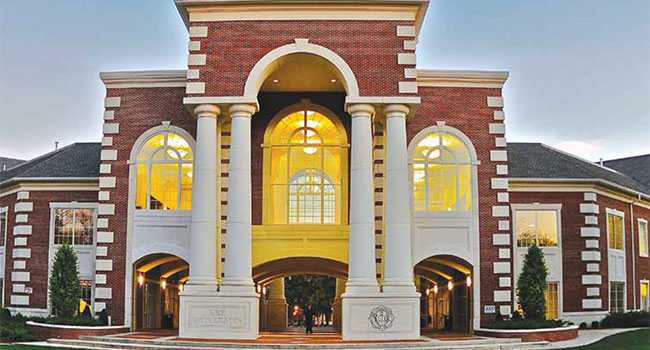
Ensuring Intelligent Security Operations
Lee University upgrades video event management system
- By Steve Birkmeier
- November 01, 2017
LOCATED IN THE FOOTHILLS OF THE APPALACHIAN
MOUNTAINS IN CLEVELAND, TENN., LEE UNIVERSITY IS A
PRIVATE CHRISTIAN UNIVERSITY THAT OFFERS A COMPREHENSIVE
LIBERAL ARTS EDUCATION WITH 52 DIFFERENT
MAJORS AND 120 INDIVIDUAL STUDY PROGRAMS.
THE UNIVERSITY BOASTS AN ENROLLMENT OF
MORE THAN 5,000 STUDENTS FROM 49 STATES AND 54
COUNTRIES.
Lee University has consistently been ranked as a “Top Tier” school
in the South by U.S. News and World Report, and has also been rated
by the Princeton Review as one of the best colleges in the southeast.
The campus itself is vast, encompassing more than 100 acres and featuring
a variety of academic buildings, athletic facilities and student
dormitories. And while crime is not as big of a challenge for the university
as it is for schools that are located in major urban areas, the
campus is certainly not immune to it.
About four years ago, the campus suffered
a rash of car break-ins that unnerved faculty
and students. In the wake of the crimes,
school administrators decided to install a network
of video surveillance cameras to augment
its security program.
According to Chris Golden, Lee University’s
director of IT Operations, the college initially
installed approximately 35 IP cameras,
which included a mix of both indoor and outdoor
models, as part of what was phase one of
a larger surveillance project intended to provide
greater video coverage throughout the
campus. While the majority of the cameras
were focused on parking areas to address the
growing threat of car burglaries, some were
also deployed inside one of the school’s student
recreation centers to help deter theft,
and monitor high-traffic entries and exits.
However, it wasn’t long after the network was
up and running that security staff began having
trouble with the video management system,
which was an appliance-based solution.
“The software we had was complicated and
clunky. When we wanted to review footage,
operators had to change video settings,”
explained Golden. “And anytime there was
incident and they had to view recorded video,
IT had to get involved and retrieve the video
file. Things shouldn’t be that hard.”
The old VMS was such a hindrance, in fact,
that it ended up costing the university more
money than they had originally budgeted
because every time a camera was added to the
network, more storage was needed to accommodate
it.
To help alleviate the burden the VMS was
placing on the video system, Lee University
consulted with a group of trusted vendors and
resellers. After evaluating a number of the top
brands in the industry, the university opted to
deploy Arteco’s Video Event Management
System (VEMS).
According to Golden, Arteco’s VEMS solution
helped the university address some of its
biggest challenges. Among these were making
sure the university could meet its video storage
retention requirements, not overtaxing
the network as more cameras were added,
providing security staff with a user-friendly
experience, and reducing the time IT had to
spend interacting with the system.
“We’re just a small IT shop, so the more I
can pass a system on to my team and only step
in when there are problems, the better it is for
me. Then I can spend my time with other
higher priority issues,” Golden said.
Given the scale of the university and the IT
infrastructure management responsibilities,
the process of migrating to a new video management
system had to be seamless as well.
“We handed the Arteco system off to our
campus safety team and now when there is
any kind of incident, they can pull the video
themselves,” Golden added. “Also, when there
is turnover in the security department, they
can simple manage user access to the system
and make any necessary changes.”
Having used the Arteco VEMS platform for
nearly three years now, Golden said the difference
in video management quality they’ve
experienced has been night and day. Not only
has the security staff enjoyed a more userfriendly
experience, but they rarely, if ever,
have contact to university’s IT team. In fact,
during a recent computer upgrade, several
campus safety officers were able to download
the software and set it up on their newly issued
university laptops with very little assistance.
From an IT perspective, Golden said the
Arteco software has not only been simple and
straightforward to manage, but he’s also
received top notch technical support—be it
through online tutorials or a quick phone call.
Golden said that Lee University has seen
both tangible and intangible benefits as a result
of the Arteco deployment. Video has aided in
the capture of people breaking into cars and
harassing others on the campus. In one particular
instance, the video was turned over to
the Cleveland Police Department, which made
several arrests as a result. Beyond that, Golden
said students and faculty members now feel
safer knowing that video surveillance is an
additional tool for campus safety.
“It gives our students a sense of security.
They can focus on their academics and having
a good experience at college,” he said. “Every
now and then one of the campus safety directors
will come up to me and say, ‘hey, the system
paid off again, we were able to solve a
crime and get the video over to the police
department and they made an arrest,’ and that
makes you feel good.”
The university is currently planning to
embark on phase two of its video project,
which will greatly enhance the number of cameras
on campus, as soon as funding can be
secured. Golden said the
Arteco VEMS will serve
as the backbone of all
future video deployments
on the campus.
This article originally appeared in the November 2017 issue of Campus Security Today.